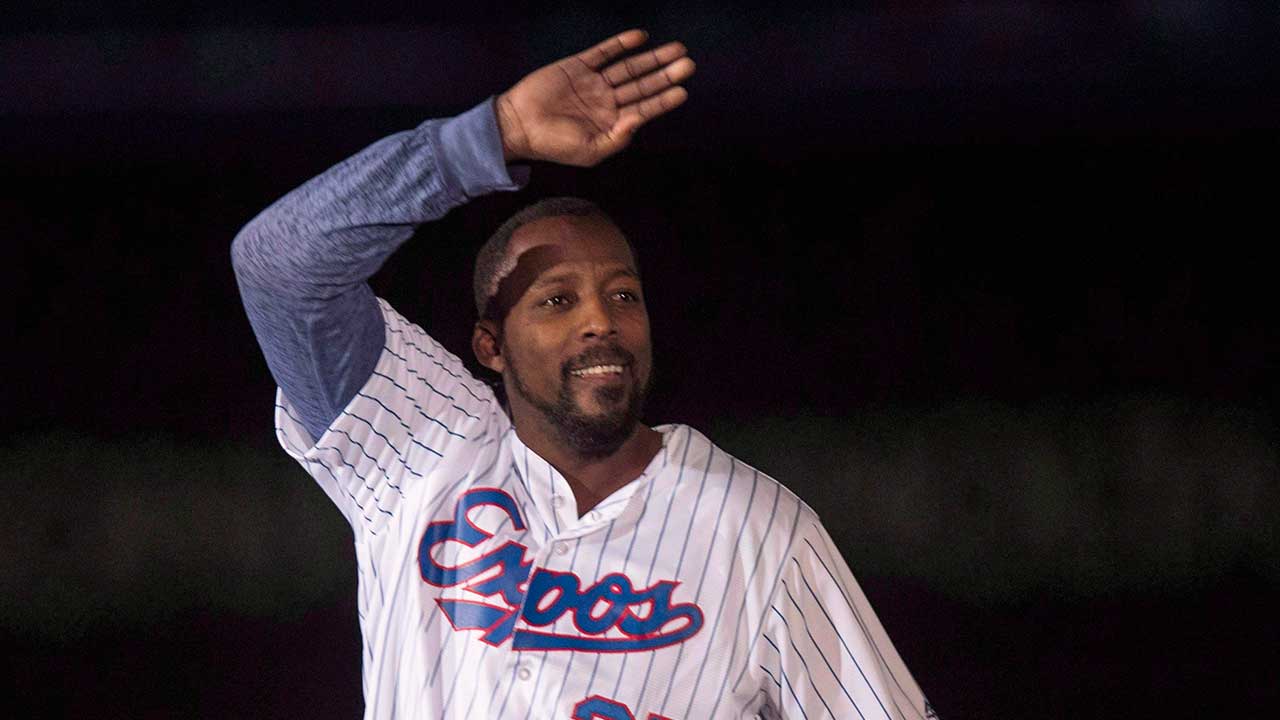DUNEDIN, Fla. — When you manage a team featuring Vladimir Guerrero Jr., you get used to seeing some pretty cool stuff. Things you don’t often see. The way the ball comes off his bat. The pitches all over the zone — and sometimes outside of it — that he barrels for extra bases. The line drives that don’t stop until they hit a wall or clear it. The fact the 18-year-old third baseman has walked more times (74) than he’s struck out (60) in his first full season of professional baseball.
It’s just every day with this kid. But when Dunedin Blue Jays manager John Schneider took his team east to play the St. Lucie Mets earlier this month, even he was taken aback.
For starters, Guerrero went 6-for-11 in the series with a couple homers, a double, and a pair of walks for good measure. One of those homers came on the first pitch of an at-bat — a breaking ball that Guerrero jumped all over and rocketed well beyond the centre-field fence 410 feet away. The fact the Toronto Blue Jays prospect squared that pitch up so well means one of two things: either he was sitting on a first-pitch breaking ball or he was able to recognize the pitch so early, and make an adjustment so quickly, that getting surprised with it didn’t matter. Hitters his age aren’t supposed to know how to do either of those things.
Then there was Guerrero’s at-bat against Jeurys Familia, the flame-throwing right-hander who saved 51 games for the major-league Mets last season and was in St. Lucie on a rehab assignment. Familia’s too good for high-A hitters. He struck out the side in his inning of work, including Guerrero. But what was notable about Guerrero’s at-bat was that Familia wouldn’t come in to him. He threw nothing but high-90s fastballs on the plate to the other batters he faced, but when it came to Guerrero he threw breaking balls and sinkers, dancing around the zone as baseball’s No. 2 prospect worked the count full. Although he finally got Guerrero to chase strike three, Familia refused to challenge the teenager. That said something.
[pullquote]
“He’s so strong that he can hit liners to shortstop that somehow go out. It’s pretty unreal.”
[/pullquote]
And then there was the crowd. St. Lucie’s set a single season attendance record this year, in large part because their everyday left-fielder is a fellow by the name of Tim Tebow. Perhaps you’ve heard of him. But when the Blue Jays came to town, the Heisman Trophy winner took a back seat.
“We had more people on our side, behind our dugout, than Tebow did over on his, which was pretty funny,” Schneider says, sitting in his office at Florida Auto Exchange Stadium a week later. “We’re seeing people waiting in hotels. We’re seeing people running after our bus. It’s amazing to see in the minor leagues — and in A-ball for that matter — that he’s being followed around by all these fans.”
Apparently, word has gotten out. Word that Guerrero is one of the best prospects — and many would drop the “one of” part — in all of baseball. Word that he’s batting .325/.427/.486 with at least a hit or a walk in 101 of his 115 games this season. Word that there’s something behind all the hype around Guerrero, something that doesn’t come around too often.

Maybe no one has seen that play out quite like Bo Bichette, the 19-year-old shortstop who has fielded beside and hit ahead of Guerrero all season, from mid-A Lansing to high-A Dunedin. Bichette says Guerrero’s combination of bat speed and hand-eye coordination is unlike anything he’s ever seen.
“He’s the most talented player I’ve ever played with — like, not even close,” Bichette says. “There’s just no one like him.”
Bichette also says something strange: that Guerrero doesn’t yet know how to hit home runs. Watching him face live pitching every day, Bichette rarely sees Guerrero take the kind of uppercut, swing-for-the-fences hacks many power hitters do, even in batting practice. Rather, he hits the ball low, straight and far. Guerrero has 13 homers on the season, and Bichette doesn’t think he was trying to leave the yard with any of them.
“His home runs are like liners through the infield. They just don’t come down,” Bichette says. “I tell him all the time, like, ‘hey, hit the ball up. Try to elevate.’ But he doesn’t need to. He really doesn’t. That’s what’s so incredible. He’s so strong that he can hit liners to shortstop that somehow go out. It’s pretty unreal.”
[relatedlinks]
Dunedin’s hitting coach, Corey Hart, has trouble finding a comparable for Guerrero’s hitting ability at such a young age. He says the closest thing he’s seen to what Guerrero’s doing at 18 is what Giancarlo Stanton did at 20 in double-A. Hart was Stanton’s hitting coach that season when the current MLB home run king put up a 1.171 OPS in 53 games before earning his first big-league call up. Thing is, Stanton didn’t walk more than he struck out. Guerrero does.
“Especially for his age, that’s very, very rare,” Hart says, before reconsidering his comment. “Actually, you know what? That’s just rare for most hitters — regardless of age. Not many guys can do that. And with the power that he has? It’s impressive.”
Hart says Guerrero recognizes pitches much earlier than the typical minor leaguer, and possesses such tremendous bat speed that he can let the ball travel deeper before deciding whether or not to swing at it. He also understands pitch movement better than most, and has an uncanny ability to determine where a pitch will end up based on where it starts out of the pitcher’s hand.
By way of example, Hart cites sliders down and away from right-handed pitchers — a particularly tantalizing pitch for right-handed sluggers like Guerrero. Thrown correctly, the pitch starts on the plate and looks awfully hittable before darting out of the zone. Hart sees plenty of minor-leaguers start their swings and struggle to hold back as that pitch sweeps away from their bat path. In those situations, the best-case scenario is a checked swing or a foul ball. The most likely case is a whiff.
“But with Vladdy, it’s an early no for him. He just lays off because he sees it so well,” Hart says. “It’s fun to watch. And then if he’s getting pitches to hit? He can take over a baseball game.”
[snippet id=3526033]
Guerrero’s mid-season promotion to Dunedin was supposed to be a challenge for him. After he put up an .888 OPS in his first 71 games of the year in the Midwest League, the Blue Jays decided to see what he could do against higher velocity and tougher breaking pitches in the Florida State League — a circuit known to be favourable to pitchers, where the average OPS this season is .682, the lowest in full-season ball.
Guerrero’s response has been to put up a .953 OPS in his first 44 games at the level, making things look easy and getting better as the summer’s worn on, which is the opposite of what you’d expect from a player who topped out at 62 games last season.
“Things are definitely sharper. The pitchers are a little bit better,” Guerrero says of high-A ball through teammate and translator Josh Almonte. “Whatever weakness a team feels like I have, they’ll continue attacking that until I make an adjustment. But I think I’ve made those adjustments.”
Guerrero says he’s seen a lot more breaking balls since advancing to high-A, which has spurred him to bear down on his plate discipline. Guerrero’s blessed with his father’s ability to get the barrel of his bat to balls all over the strike zone, and sometimes outside of it. But his focus at the plate now is swinging at better pitches to hit, and not offering at all those breaking balls so he can eventually get to a heater.
His coaches say that’s behind Guerrero’s torrid late-August stretch, which saw him go 22-for-49 with a 1.292 OPS over 14 games. Even though he has the ability to put bad balls in play for hits, he hasn’t, opting instead to only swing at the best pitches he’s getting.
[snippet id=3305549]
Defence is also a major focus. Guerrero is drilled every day on his first step quickness and lateral movement as the Blue Jays try to expand his range at third base. Guerrero has only played the position for a couple years, but says he’s grown much more comfortable with it this summer in particular. He feels himself getting to balls that he once couldn’t, which is a big progression for Guerrero because, by all accounts, his throwing arm is developing into a considerable weapon.
“He’s got a huge arm. An arm just like his dad,” Schneider says. “You see him make plays down the line where he has to hurry on bunts or slow rollers — you watch the throw and you’re like, ‘whoa.’ It’s plus. It’s accurate. And it’s going to continue to get better, I think.
“I’ve seen him make major-league type plays since he’s been here. I’ve seen him make plays that other third basemen in this league can’t make. Just seeing where he is defensively now compared to when I saw him in spring training, and even last year, is tremendous. He’s taken huge strides. You’re looking at a kid who, two years from now, when he’s 20 or 21 and coming into being a young man, could be really special.”

But for now, he’s only 18, meant to be enjoying the summer between his senior year of high school and his freshman year of college. Of course, Guerrero doesn’t exist in that world. But even in the baseball realm, he’s meant to be in short-season ball, which is where most players his age are.
Instead, he’s tearing up a league where the average player is five years older than him. He’s younger than some players selected out of high school in this June’s draft. That’s why they’re chasing after his bus, flocking to him after batting practice, and waiting for him at hotels.
“It is kind of funny that there’s people at the hotel looking for my autograph,” Guerrero says. “I’ll sign a few. But I’m trying to go back to my room and rest. I’m pretty tired. I can’t get to everybody, but I try to.”
Asked if his teammates give him a hard time about all the attention he’s receiving, Guerrero shakes his head “no” while Almonte nods his head “yes.” Of course they do. How couldn’t they? But that’s the last thing Guerrero wants to think about.
“I just try to go out there and play to the best of my abilities. Whatever happens outside of baseball, I’m not really in control of that,” he says. “I guess from me playing well, that’s the attention that I’m getting. But once I walk into the clubhouse, I just try to act like I’m no different than anybody else. I’m trying to give it my all and give the best I can to help my team win. I just try to bring that mindset every day. And just play baseball.”








